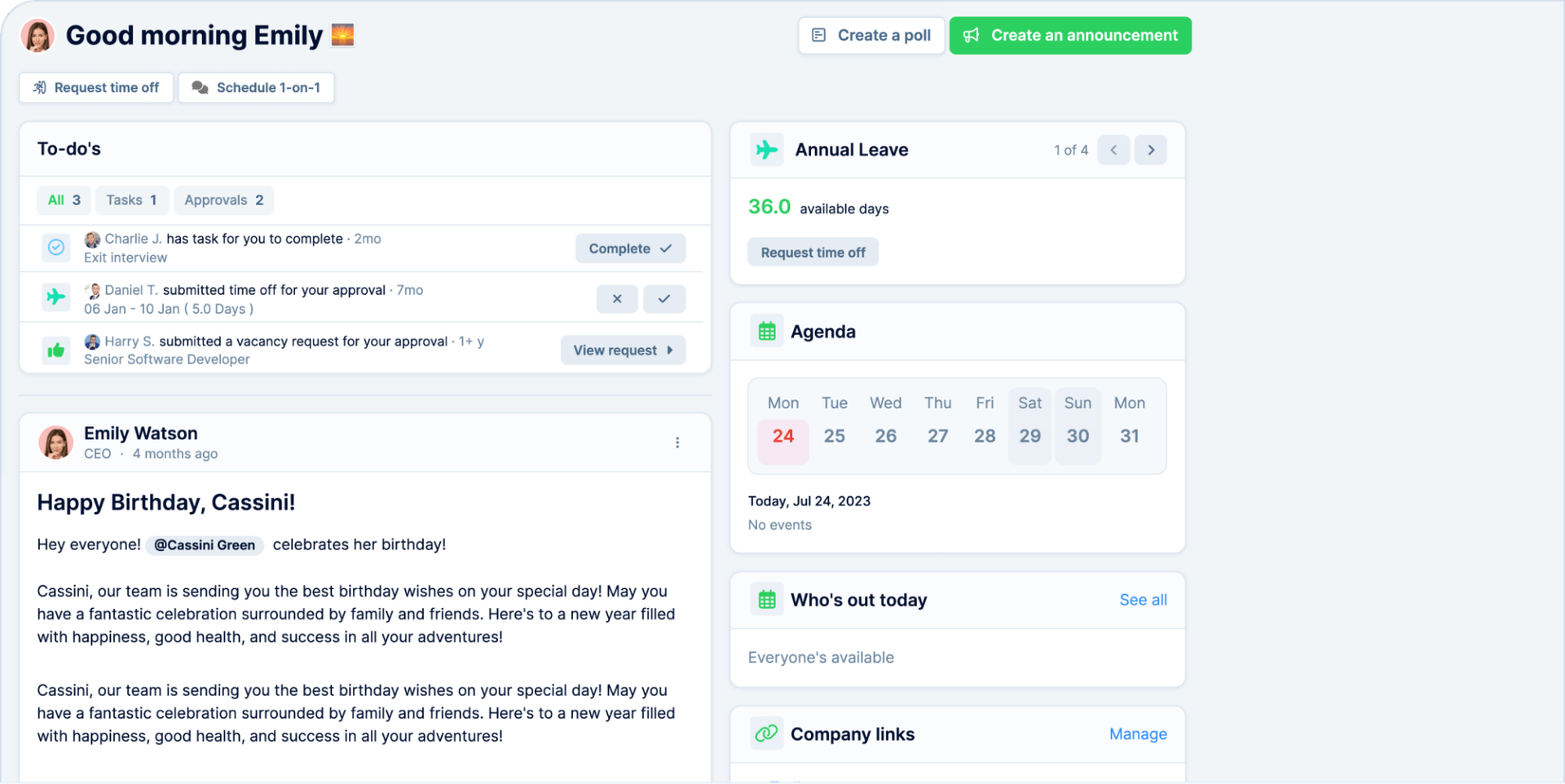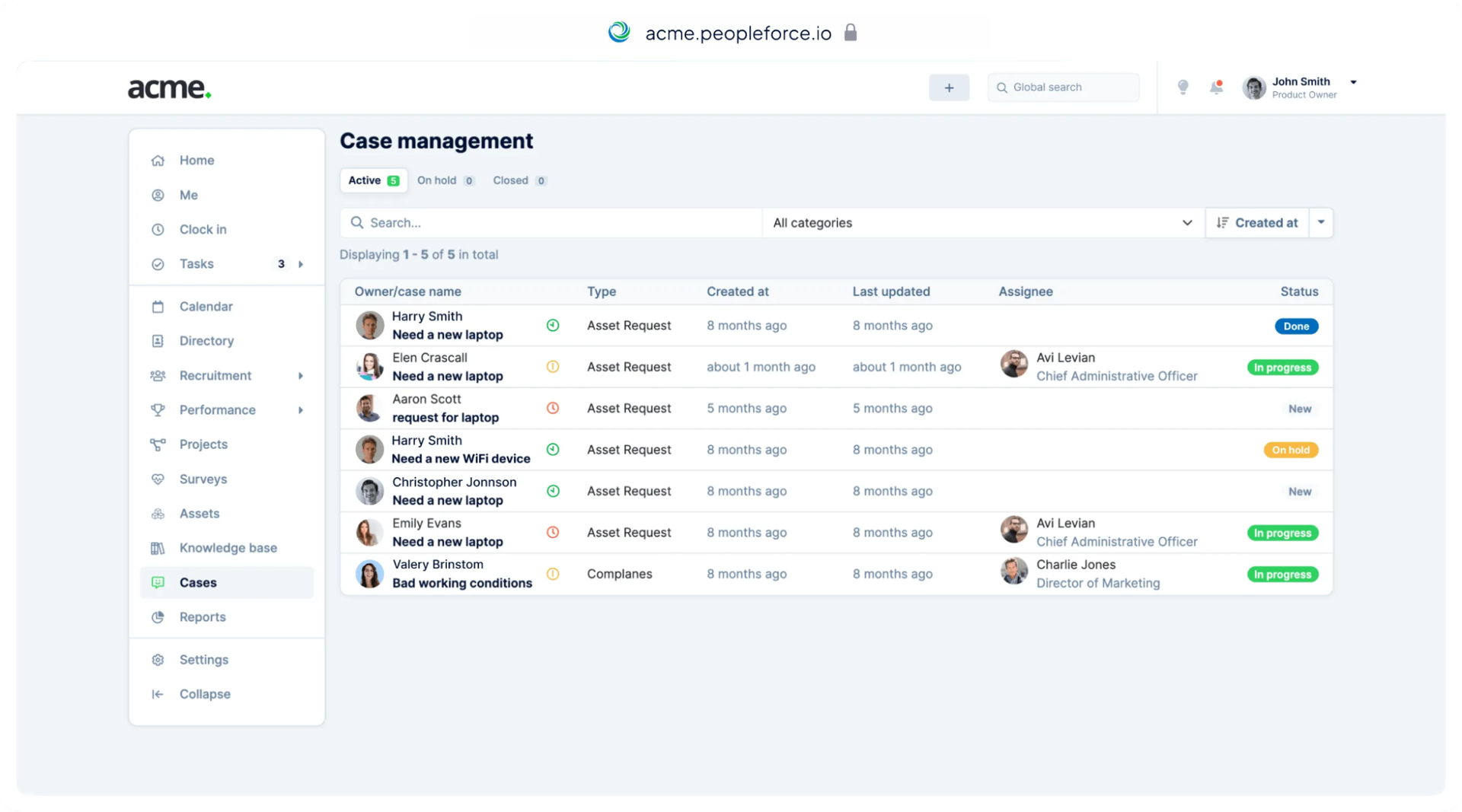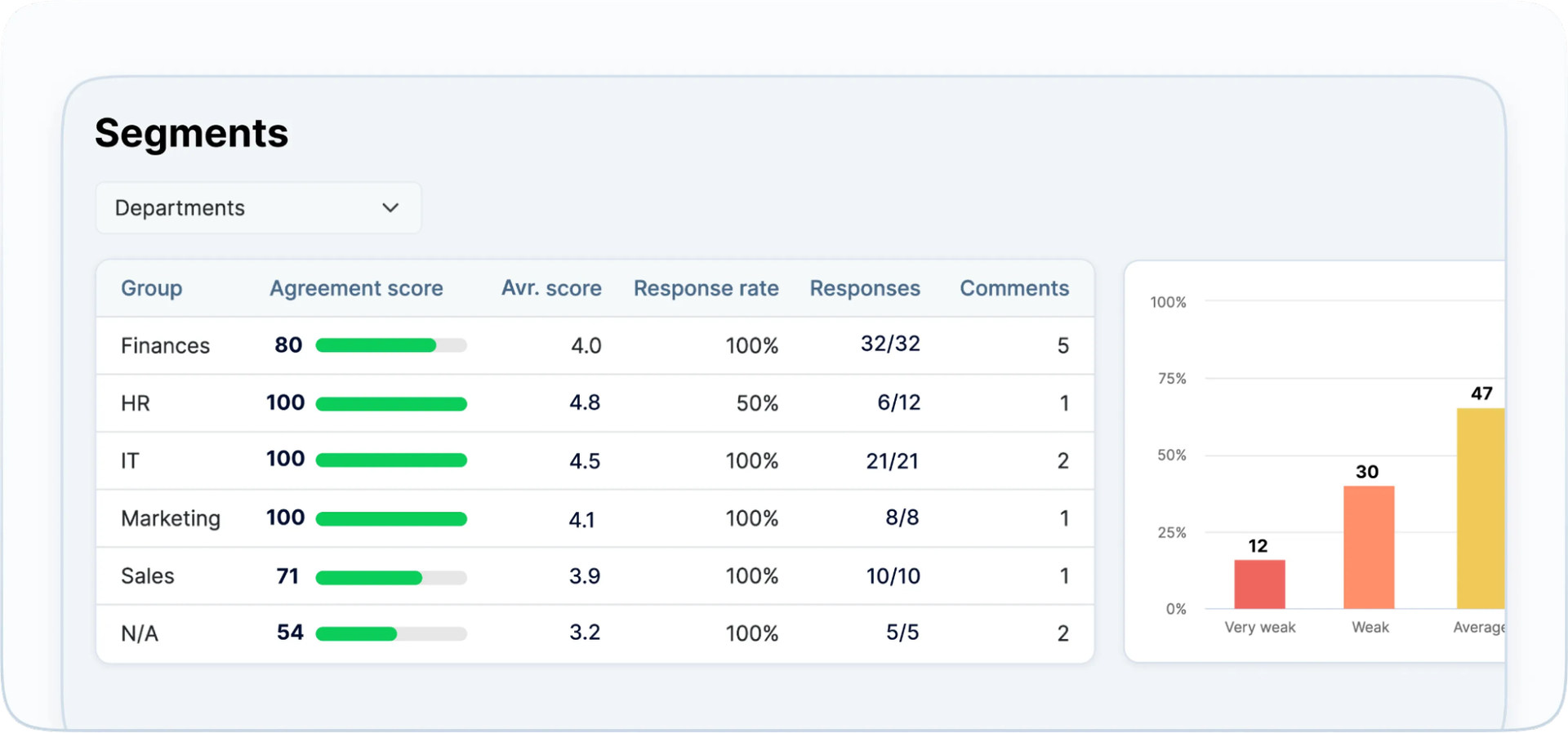
Employee Motivation: Discover the 15 Most Important Motivators for a Productive Work Life
Do you want a team that takes initiative and consistently delivers results? Sustainable employee engagement isn’t just a matter of skills – it depends on whether your organization creates the right conditions to keep employees motivated. When you understand what drives employee motivation, you build loyalty, enhance productivity, and reduce the need for constant oversight or micromanagement.
Let’s start by clarifying the difference between employee motivation and employee engagement.
Motivation is the internal drive or external incentive that pushes someone to take action. It explains why a person wants to work – whether it’s to achieve a goal, earn a reward, or find meaning in their role. Highly motivated employees are more likely to take initiative, stay loyal to the company, and actively seek out opportunities for personal growth.
Engagement, on the other hand, reflects how emotionally and behaviorally invested someone is in their work. It shows in their commitment to company goals, the quality of what they deliver, and the discretionary effort they put in. Engaged employees want to work for the organization, not just at it.
Motivation without engagement is untapped potential. Engagement without motivation, however, can lead to burnout. That’s why a strong motivation strategy must address both – fueling the desire to act and the commitment to contribute. When intrinsic and extrinsic motivation are aligned with employee engagement, you lay the foundation for lasting performance and genuine job satisfaction.
Intrinsic Motivation and Beyond: Applying the 15 Most Important Motivators for a Productive Work Life
While there’s no single formula for keeping every employee motivated, there are proven motivational factors that work across industries, company sizes, and employment models. These drivers are the foundation of a strong employee engagement strategy – and they influence whether someone feels motivated to contribute, grow, and stay with your organization.
Each of these factors helps determine whether employees will go beyond performing tasks and truly invest in their work. They generally fall into three core categories:
🎯 Intrinsic motivators – based on personal values and higher-level needs, such as the desire to learn or grow professionally.
🤝 Social motivators – rooted in relationships, collaboration, communication, and team dynamics.
💼 Extrinsic motivators – tied to external factors such as compensation, work conditions, and job security.
Effective employee motivation comes from combining these elements in ways that reflect your people’s individual needs and preferences. Organizations that invest intentionally in both intrinsic and extrinsic motivation can achieve impressive results – with some reaching employee engagement rates as high as 70%, compared to the global average of just 21%, according to Gallup.
Let’s explore which of these strategies you can start using right now to support a more motivated workforce.
🎯 1. Autonomy
Autonomy isn’t about rejecting structure or company goals – it’s about allowing employees to have control over how they approach their work. This is a particularly strong intrinsic motivator for creative professionals and experienced specialists who have developed their own effective methods. Junior team members may appreciate it too, though they often benefit from more structured support.
A 2020 study found that autonomy at work increases employee productivity by an average of 5.2%. So, how can you use this motivator to empower your team?
- Flexible schedules – Let employees work during their most productive hours. As chronotype researcher Daniel Pink notes, performing tasks at the wrong time of day can lower performance and energy levels.
- Choice of tools – When multiple tools offer similar features and cost, allow employees to choose the one that works best for them, rather than enforcing a one-size-fits-all solution.
- Project ownership – If the process or sequence of tasks isn’t critical, define the goal and deadline – then let employees plan how to achieve it. When people feel ownership over the process, their internal drive and sense of responsibility grow.
- Remote and hybrid work options – If physical presence isn’t essential, allow employees to choose their ideal work environment – whether that’s the office, home, or a coworking space. This flexibility contributes to a better employee experience and higher motivation.
🎯 2. Skill Development
In nearly every team, you’ll find individuals who are eager to grow, learn, and expand their competencies. These are often ambitious mid-level employees who see a long-term future with the organization – especially in fast-paced fields like tech, marketing, and finance. Supporting their personal growth is a smart way to increase employee engagement and boost motivation.
Here’s how to support motivated employees through skill development:
- Learning budgets – Offer employees a personalized budget for training and development. Time-limited budgets (e.g. “use it or lose it” by year-end) are especially effective for encouraging proactive planning and avoiding delays.
- Challenging assignments – Assign projects that push people to develop new skills or step outside their usual routines. This creates meaningful learning opportunities and increases both engagement and confidence.
- Certifications and continued education – Help team members grow by covering (or co-financing) professional certifications or postgraduate studies that enhance their qualifications.
- Networking and industry events – Encourage employees to attend conferences, meetups, and workshops. These opportunities build expertise, connect people with co-workers, and position your company as a place where career development is truly valued.
🎯 3. Purpose and Meaning
A sense of purpose is a foundational driver of intrinsic motivation – and one of the most effective ways to increase long-term employee engagement and retain top talent. When employees understand why their work matters and how their tasks contribute to the team’s success, they feel more responsible and take more initiative. This motivation factor is especially relevant in nonprofit organizations and support roles (like Human Resources, admin, or back office), where the impact of one’s work may not be immediately visible.
Here’s how to reinforce purpose in daily work:
- Communicate the company’s vision and values – Don’t limit messaging to onboarding slides. Remind your team regularly what your shared goals are and how their work supports customers, partners, or the wider community.
- Show how individual roles contribute – Don’t just assign tasks; explain how each responsibility connects to broader business objectives. Instead of saying “Update the customer database”, try: “Your database updates help our sales team respond to inquiries faster, which improves customer satisfaction”.
- Involve employees in setting goals – Use OKRs or collaborative sprint planning to align priorities and create a sense of ownership.
- Provide feedback with context – Tie praise to larger outcomes. Instead of just saying, “Thanks for the report”, try: “Your report helped leadership make a key decision to expand into a new market”.
- Share real stories – Use your internal channels, website, or social media to highlight how your products or services make a difference. Let employees share what gives them a sense of meaning at work.
🎯 4. Intellectual Challenge
Routine kills engagement. Many high-potential employees – especially in office-based or knowledge-driven roles – crave intellectual stimulation to stay in a state of “flow”, where focus and satisfaction meet. Without mental challenges, even top performers can lose their intrinsic motivation, burn out, or leave in search of more meaningful work.
To support cognitive engagement, try the following:
- Non-routine challenges – Assign projects that require strategic thinking, analysis, or conceptual problem-solving – even outside regular job duties.
- Encourage practical improvements – Let employees help identify and solve operational or business issues. When people can contribute ideas, their motivation increases.
- Host innovation sessions – Run internal hackathons, brainstorming events, or think tanks to break routine and unlock creativity.
- Vary project types – Balance tasks requiring analytical thinking, creativity, and teamwork. This keeps engagement high and encourages personal growth.
🎯 5. Recognition and Appreciation
Knowing your work is seen and valued is one of the most powerful drivers of employee motivation – across all personality types and roles. This is especially true for those in “invisible” functions like IT, logistics, or admin, who rarely get direct praise from customers. Regular and meaningful employee recognition boosts morale, builds trust, and strengthens company culture.
Here’s how to do it right:
- Timely appreciation – Don’t wait until quarterly reviews. Acknowledge valuable contributions as they happen. Encourage peer-to-peer positive feedback through kudos tools, nomination systems, or dedicated Slack channels like #praise.
- Be specific – Point out what exactly deserves recognition and what impact it had on the team or business. Praise results and effort, including learning moments or bold new ideas.
- Tailor the format – Not everyone likes public praise. Respect preferences – sometimes a 1:1 thank-you has more impact than a team shoutout. Creating space for authentic appreciation helps employees feel respected and motivated to go the extra mile.
🤝 6. Interpersonal Relationships
When employees feel connected, supported, and trusted by their team members, their work motivation increases naturally. On the flip side, tension or isolation is one of the leading causes of frustration, lost productivity, and high turnover – especially in hybrid or distributed workplaces.
Strong relationships are especially vital in sales, HR, customer support, and teams working in open office environments. Here’s how HR professionals and managers can enhance employee motivation by fostering interpersonal connections:
- Create opportunities for informal connection and collaboration – Not every interaction has to be work-related. Encourage casual conversations, idea sharing, and daily check-ins – especially with remote and hybrid teams. Building an emotional connection enhances the overall employee experience.
- Introduce low-pressure team-building activities – You don’t need full-blown retreats to improve employee engagement. Simple initiatives like team lunches, celebrating small wins, or informal online meetups (with no set agenda) can go a long way in creating a sense of belonging.
- Encourage feedback and peer support – Open communication is the foundation of motivated teams. Offer opportunities for team members to share positive feedback, exchange support, and welcome new hires. Programs like buddy systems, welcome team meetings, informal Slack channels (e.g., #new-hires), team lunches, or regular 1:1s with managers can significantly improve onboarding and help new employees feel part of the team from day one.
🤝 7. Collaboration
Collaboration isn’t just about dividing up tasks – it’s a way of working that helps employees feel part of a shared purpose, learn from one another, and build soft skills. Highly collaborative teams adapt quickly to change and deliver stronger business outcomes – even under pressure.
Collaboration acts as a strong employee motivation driver in cross-functional projects, product teams, and any setting where success depends on bringing different skill sets together. Here’s how to encourage teamwork and foster collaboration within your organization:
- Promote shared ownership and responsibility – Design tasks that require input from multiple team members, not just parallel individual efforts. A sense of joint accountability boosts both engagement and the overall employee experience.
- Encourage knowledge sharing – Build a culture where exchanging ideas and learning together is part of everyday work. Use internal lessons learned sessions, peer presentations, or project retrospectives to support ongoing learning and reflection.
- Celebrate team achievements – Recognize group accomplishments and show how collaboration drives progress toward company goals. Highlight success stories in internal communications and public shout-outs.
- Facilitate cross-team communication – True collaboration doesn’t end at departmental boundaries. Ensure employees can connect, share expertise, and solve problems together – even across business units. Use your HR platform’s features like internal knowledge bases, shared channels, and integrated communication tools to support seamless collaboration.

🤝 8. Mentoring
For many experienced professionals – especially those in senior roles – serving as a mentor is more than just a responsibility. It’s a source of intrinsic motivation that reinforces their expert identity, boosts interpersonal skills, and strengthens their employee engagement. When done right, mentoring becomes a powerful way to retain talent and improve productivity across teams.
Here’s how to turn mentoring into a sustainable motivation strategy:
- Encourage knowledge sharing – Create a workplace culture where mentoring is seen as an opportunity for growth, not just an added task. As seen in companies like General Motors, mentoring builds leadership pipelines, reduces skill gaps, and fosters collaboration. It also supports employee retention by reinforcing a sense of purpose.
- Give mentors the space to contribute – Enable senior employees to lead 1:1 mentoring sessions, host team-wide Q&As, or run internal trainings based on their areas of expertise.
- Recognize the mentor’s impact – Don’t focus only on the mentee’s success. Acknowledge the mentor’s effort and commitment – this recognition boosts morale and builds a motivated workforce.
- Support structured mentoring with HR tools – Use features in your HRM platform like development goals, 1:1 notes, and learning history to match mentors with mentees, track progress, and promote best practices across the organization.
🤝 9. Sense of Belonging
According to the 2022 Workplace Belonging Survey, 88% of U.S. employees say that a sense of belonging directly impacts their productivity – with 54% strongly agreeing. But belonging isn’t created by a job contract. It’s built through relationships, emotional connection, and inclusive culture. For engaged employees, it’s not just about what they do – it’s about being seen and accepted for who they are.
Belonging is one of the strongest emotional motivators, especially in remote or hybrid teams, and it starts long before the first day of work. Here’s how to nurture it:
- Involve employees in meaningful conversations – Invite employees to share their opinions, especially when it comes to decisions that affect day-to-day work or team direction. This builds psychological safety and trust.
- Make individual contributions visible – Show how each person’s work supports team success. Even behind-the-scenes roles – like testers, IT admins, or infrastructure specialists – deserve recognition and a clear sense of impact. When people feel that their presence matters, their motivation at work increases naturally.
🤝 10. Communication
Clear and consistent communication is the foundation of effective employee engagement – especially in global, distributed, or hybrid teams. If people don’t understand what’s expected of them or how their work connects to the bigger picture, employee motivation will suffer.
Here’s how to improve communication to better engage and empower your team:
- Clarify goals and expectations – Make sure employees know what they’re responsible for, why it matters, and what business success looks like. Avoid vague instructions and tie tasks to business priorities.
- Be transparent about decisions – Even when strategic decisions aren’t made collaboratively, communicating the reasoning behind them helps employees feel included and respected. When announcing budget cuts, explain: “We're reducing the office supplies budget to invest more in employee training, based on your feedback about wanting more development opportunities”.
- Create space for two-way feedback – A healthy feedback culture involves listening, not just talking. Invite feedback from employees and act on it. Use your HR system to support anonymous surveys or feedback channels to better understand employee needs and improve the overall employee experience.

💼 11. Fair Compensation
While financial motivation isn’t the only factor driving employee engagement, it remains one of the most fundamental. Even the most inspiring tasks won’t motivate someone who feels their effort is undervalued. Fair compensation sends a clear message: the organization respects its people and recognizes their contributions.
Here’s how to align your employee compensation strategy with a culture of appreciation and fairness:
- Run regular pay audits – Evaluate your internal pay structure and compare it with market benchmarks to avoid unjustified disparities. Transparency is key to building trust and motivation.
- Set clear compensation policies – Define salary bands and outline how raises and bonuses are awarded. When employees understand what influences their compensation, it helps strengthen their sense of fairness and control.
- Offer performance-based employee rewards – Use financial incentives strategically, such as quarterly bonuses or one-time rewards for exceptional initiative and above-and-beyond performance. Recognition tied to effort reinforces a culture of merit and total rewards.
💼 12. Work-Life Balance
Work-life balance is more than a perk – it’s a fundamental driver of employee well-being, especially for parents of young children, older workers, and those in high-stress or overtime-heavy roles. When employees have time to rest, care for their families, and pursue personal passions, they’re healthier, more focused, and more motivated to contribute.
How can you support work-life balance in practice?
- Flexible hours and location – Empower employees to work during their most productive hours and in the environment that best suits them – whether that’s in-office, remote, or hybrid – based on clear policies and expectations.
- Respect personal time – Don’t normalize 24/7 availability. Encourage managers to model healthy boundaries by not sending work messages after hours or expecting instant replies.
- Meeting-free focus time – Block out recurring time each week for deep work. Minimizing interruptions increases productivity and helps reduce stress.
- Support for caregivers – Offer family-friendly employee benefits such as daycare support, easier vacation scheduling, and extra time off during family emergencies. These measures show that the company genuinely values employee well-being and burnout prevention.
💼 13. Job Security
Job security is a key extrinsic motivator, especially for frontline workers, production staff, and employees in high-turnover industries or regions with limited job opportunities. The fear of losing one’s job undermines trust, discourages initiative, and reduces employee engagement. On the other hand, when employees are confident in their long-term future with the company, they’re more likely to focus on career development and long-term goals.
Here’s how to build a greater sense of stability and trust:
- Transparent communication – Keep employees informed about the company’s financial health, organizational changes, and performance results. A lack of timely and honest information can lead to rumors and anxiety, damaging morale and trust in leadership.
- Tailored employment offerings – Many employees value more than just salary. Predictable scheduling, clear contracts, and consistent working conditions all contribute to a sense of stability. Align your employment policies with the real needs of your workforce.
- Provide stable employment contracts – Whenever possible, avoid last-minute contract extensions or excessive reliance on temporary contracts. Offering permanent roles or longer-term agreements is especially important in maintaining employee retention among manual and shift-based workers.
💼 14. Promotion Opportunities
Offering a clear and compelling career development path is one of the most effective ways to drive employee motivation. While not every team member aims for a leadership role, most employees expect opportunities to grow their skills, take on greater responsibility, or move into more specialized positions over time.
Even the most attractive non-monetary benefits lose their motivational power if there's no room for advancement. To make promotion opportunities a lasting motivator, they must be supported by tangible initiatives:
- Career pathing and visibility – Show employees how they can advance within your organization. This includes both vertical moves (e.g., from junior to senior specialist) and lateral growth (e.g., shifting departments, changing focus areas, or stepping into leadership roles). A transparent org structure helps employees map out their career journey.
- Ongoing career conversations – Don’t wait for annual reviews to discuss goals and ambitions. Regular development check-ins allow managers to understand employee aspirations, identify readiness for new challenges, and plan next steps strategically.
- Prioritize internal mobility – Before hiring externally, evaluate internal candidates. Promoting from within fosters employee loyalty, reduces onboarding time, and cuts recruitment costs – your internal talent already knows your processes, tools, and culture.
- Learning through experience – Career growth doesn’t always require formal training. Delegating stretch assignments – like leading a project, covering for a manager, joining interviews, or onboarding new hires – can help employees build new skills and gain confidence in more demanding roles.
💼 15. Work Environment
The physical and psychological work environment plays a significant role in employee motivation – even though it’s often overlooked. A well-designed, respectful, and supportive space can greatly improve employee performance, focus, and job satisfaction.
How can you use the work environment to effectively motivate employees?
- Prioritize ergonomics and comfort – Proper lighting, comfortable workstations, quiet zones, and access to basic facilities all support focus, well-being and higher productivity. Small upgrades can have a big impact.
- Provide reliable tools and clear processes – Nothing demotivates like broken equipment or unclear workflows. By investing in functional tools and organized workflows, you show that you value your employees’ time and effort.
- Create spaces for communication and collaboration – The workplace should support more than just task execution. It should also foster idea sharing, collaborative problem-solving, and informal conversations. This applies to both office-based and frontline teams.
- Build a company culture of respect and recognition – A motivating environment isn’t just about the physical surroundings, but also the emotional climate. Recognize employees not only for outcomes but also for their engagement, proactivity, and willingness to help. For many, these gestures are the most enduring forms of extrinsic motivation.
Motivated Employees Start with Insight: How to Measure the Effectiveness of Your Actions
When introducing new motivators – whether related to non-monetary incentives, career growth opportunities, the work environment, or other benefits – it's essential to track whether they drive the desired outcomes in terms of employee engagement and overall team performance.
Here are a few proven methods HR professionals can use:
- Employee engagement surveys – Regular pulse checks or eNPS surveys can help you monitor team sentiment and identify areas for improvement. Don’t just ask about overall satisfaction – dig into specific factors like recognition, growth opportunities, team relationships, and working conditions. Ask questions like: “What part of your work do you find most engaging?” “What's one thing that would make your workday easier?” “How do you prefer to receive feedback?”
- 1:1 conversations – Quantitative data is valuable, but there’s no substitute for meaningful conversations with team members. Ask openly what motivates them, what causes frustration, and what could be improved. This helps tailor your motivation strategy to individual needs – and boosts employee experience in the process.
- Turnover and retention rate – A rising number of resignations, especially among high performers or highly engaged employees, may signal that your employee motivation system isn’t meeting expectations or providing a strong enough sense of security.
- Absenteeism and productivity metrics – Increased absenteeism or declining business performance can signal early signs of burnout, disengagement, or a disconnect between employee motivation efforts and the real employee experience at work.
- Interest in development opportunities – Track participation in training programs, mentoring, and stretch projects. These are strong indicators of intrinsic motivation and an employee’s willingness to take initiative.
You don’t need advanced Human Resources analytics to start. Even simple, consistent diagnostic efforts can help you assess which motivation techniques are effective – and which need to be adapted to meet your team’s evolving needs and workplace realities.

Common Mistakes That Undermine Employee Motivation
Research released as part of the My Whole Self 2025 initiative reveals a striking statistic: only 17% of employees feel motivated to go to work each day. That’s surprisingly low – especially considering how much effort organizations invest in motivation and engagement strategies.
So why do so many efforts fail to increase employee motivation or deliver real business outcomes? Here are some of the most common mistakes:
One-size-fits-all approach – Different groups, such as frontline workers, office staff, and production teams, have different needs, challenges, and priorities. It’s hard to keep employees motivated if you ignore the realities of their work environment and day-to-day experience.
Relying on guesswork – Without data and insight, even well-intentioned actions can miss the mark. An effective employee engagement strategy begins with listening. Without that, motivational factors become random and ineffective.
Focusing only on perks – Extrinsic motivators like bonuses or perks won’t be enough if the team lacks trust, purpose, or personal growth opportunities. A well-designed incentive program is just one part of the puzzle – not a substitute for a healthy company culture.
Inconsistency – Motivation suffers when an organization sends mixed signals. For example, talking about trust while micromanaging, or encouraging development but offering no learning opportunities. Highly motivated employees thrive when words align with actions.
Neglecting recognition and communication – A lack of employee feedback, absent leadership, and failure to recognize employees for their contributions can quickly erode morale. Positive feedback, even for small wins, builds emotional connection and boosts motivation.
To improve employee motivation, you need a thoughtful, adaptable approach based on understanding what truly drives people to put in discretionary effort. That means listening, learning, and having the courage to experiment with what actually motivates your entire workforce.
Intrinsic and Extrinsic Motivation – Final Thoughts on Driving Engagement and Productivity
Employee motivation is built in everyday interactions – in how you assign tasks, respond to ideas, and create space for initiative. A team member who understands the purpose behind their work is more likely to be an engaged employee over the long term. Someone driven only by extrinsic rewards, like bonuses, will stay loyal only until another company offers more.
Start with the basics: recognize employees more often, explain the “why” behind each task, and empower employees with greater autonomy in how they get things done. These simple actions cost nothing – but can immediately help boost employee motivation.
The rest comes down to listening to your team members and adapting your efforts to what genuinely drives their work motivation. That’s how you build a motivated workforce ready to go the extra mile – not just today, but for the long haul.
Get started with PeopleForce today
Automate your HR routine to create a high performance culture in your company. PeopleForce is your best HRM alternative to stay business driven but people focused.

Recent articles
OKRs vs. KPIs: Choosing the right framework
Unsure when to use OKRs or KPIs? Learn how to choose the right framework to maximize your team’s success.
Why OKRs feel like hell (and how to make them simple)
Why OKRs feel like chaos: missed goals, messy reviews, and burnout. Learn how to simplify goal-setting and reclaim clarity quickly.
7 personal development habits worth adopting for career and personal growth
Unlock your potential with 7 simple personal development habits to boost career growth, productivity, and overall life balance.

